Prospects for the Application of Wavelet Analysis to the Results of Thermal Conductivity Express Control of Thermal Insulation Materials
Abstract
:1. Introduction
2. Materials and Methods
2.1. Studied Specimens
2.2. Experimental Equipment and Methods
- K—the calibration characteristic of the device (m);
- q0, q—the measured values of heat flux in the undisturbed zone and the area of local heat, respectively (W/m2);
- T0, T—the measured temperature values in the area of local heat in the undisturbed zone and the area of local heat, respectively (K).
- Thermal conductivity coefficient measurements range from 0.02 to 3.0 (W/(m∙K));
- Main relative error of ±3%;
- Operating temperature ranges from −40 to +180 (°C);
- Sample size of 300 × 300 × (10…120) (mm).
2.3. Methods of Data Processing
- First step: Selecting the right type of wavelet and decomposing the original S signal.
- Second step: Determining the thresholds at all levels of signal decomposition and threshold denoising of all detail components (high-frequency coefficients).
- Third step: Signal reconstruction.
3. Results and Discussion
4. Conclusions
Author Contributions
Funding
Institutional Review Board Statement
Informed Consent Statement
Conflicts of Interest
References
- ISO 8302. Thermal Insulation—Determination of Steady-State Thermal Resistance and Related Properties—Guarded Hot Plate Apparatus; ISO: Geneva, Switzerland, 1991. [Google Scholar]
- ISO 8301. Thermal Insulation—Determination of Steady-State Thermal Resistance and Related Properties—Heat Flow Meter Apparatus; ISO: Geneva, Switzerland, 1991. [Google Scholar]
- Zhao, D.; Qiao, X.; Gu, X.; Jajja Ayub, S.; Yang, R. Measurement techniques for thermal conductivity and interfacial thermal conductance of bulk and thin film materials. J. Electron. Packag. 2016, 138, 040802. [Google Scholar] [CrossRef] [Green Version]
- Mathis, N. Transient thermal conductivity measurements: Comparison of destructive and nondestructive techniques. High Temp. High Press. 2000, 32, 321–327. Available online: https://www.ctherm.com/files/Transient_Thermal_Conductivity_Measurements.pdf (accessed on 28 May 2021).
- Ghadimi, A.; Saidur, R.; Metselaar, H.S.C. A review of nanofluid stability properties and characterization in stationary conditions. Int. J. Heat Mass Transf. 2011, 54, 4051–4068. [Google Scholar] [CrossRef]
- American Society of Heating, Refrigerating and Air-Conditioning Engineers. ASHRAE Handbook: Fundamentals; ASHRAE: Atlanta, GA, USA, 2001. [Google Scholar]
- Brzezinski, A.; Tleoubaev, A. Effects of Interface Resistance on Measurements of Thermal Conductivity of Composites and Polymers. In Proceedings of the 30th Annual Conference on Thermal Analysis and Applications (NATAS); Kociba, K.J., Ed.; B&K Publishing: Pittsburgh, PA, USA, 2002; pp. 512–517. [Google Scholar]
- Ruuska, T.; Vinha, J.; Kivioja, H. Measuring thermal conductivity and specific heat capacity values of inhomogeneous materials with a heat flow meter apparatus. J. Build. Eng. 2017, 9, 135–141. [Google Scholar] [CrossRef]
- Li, Y.; Shi, C.; Liu, J.; Liu, E.; Shao, J.; Chen, Z.; Dorantes-Gonzalez, D.J.; Hu, X. Improving the accuracy of the transient plane source method by correcting probe heat capacity and resistance influences. Meas. Sci. Technol. 2014, 25, 015006. [Google Scholar] [CrossRef]
- Pásztory, Z.; Anh Le, D.H. An overview of factors influencing thermal conductivity of building insulation materials. J. Build. Eng. 2021, 102604, 1–16. [Google Scholar] [CrossRef]
- Lakatos, Á.; Kalmár, F. Investigation of thickness and density dependence of thermal conductivity of expanded polystyrene insulation materials. Mater. Struct. 2013, 46, 1101–1105. [Google Scholar] [CrossRef] [Green Version]
- Hotra, O.; Dekusha, O. A device for thermal conductivity measurement based on the method of local heat influence. Przegląd Elektrotech. 2012, 88, 223–226. [Google Scholar]
- Gurav, M.; Sarik, S.; Singh, K.; Pendharkar, G.; Baghini, M.S. IITB_TDR: A portable TDR system with DWT based denoising for soil moisture measurement. Sens. Actuator A Phys. 2018, 283, 317–329. [Google Scholar] [CrossRef]
- An, M.; Liu, M.; Ma, Y.; Xu, X. Multi-scale vibration behavior of a graphite tube with an internal vapor–liquid–solid boiling flow. Powder Technol. 2016, 291, 201–213. [Google Scholar] [CrossRef]
- Oh, Y.Y.; Yun, S.T.; Yu, S.; Kim, H.J.; Jun, S.C. Characterization of Environmental Drivers Controlling the Baseline of Soil Surface CO2 Flux using Wavelet-based Multiresolution State-Space Model and Wavelet Denoising. Energy Procedia 2018, 154, 157–162. [Google Scholar] [CrossRef]
- Ch’ien, L.; Wang, Y.; Shi, A.; Li, F. Wavelet filtering algorithm for improved detection of a methane gas sensor based on non-dispersive infrared technology. Infrared. Phys. Technol. 2019, 99, 284–291. [Google Scholar] [CrossRef]
- Dong, H.; Nie, Y.; Cui, J.; Kou, W.; Zou, M.; Han, J.; Guan, X.; Yang, Z. A wavelet-based learning approach assisted multiscale analysis for estimating the effective thermal conductivities of particulate composites. Comput. Methods Appl. Mech. Eng. 2021, 374, 113591. [Google Scholar] [CrossRef]
- Anstett-Collina, F.; Goffart, J.; Mara, T.; Denis-Vidal, L. Sensitivity analysis of complex models: Coping with dynamic and static inputs. Reliab. Eng. Syst. Saf. 2015, 134, 268–275. [Google Scholar] [CrossRef] [Green Version]
- Gonga, M.; Wang, J.; Bai, Y.; Li, B.; Zhang, L. Heat load prediction of residential buildings based on discrete wavelet transform and tree-based ensemble learning. J. Build. Eng. 2020, 32, 101455. [Google Scholar] [CrossRef]
- Dekusha, O.; Burova, Z.; Kovtun, S.; Dekusha, H.; Ivanov, S. Information-Measuring Technologies in the Metrological Support of Thermal Conductivity Determination by Heat Flow Meter Apparatus. Stud. Syst. Decis. Control 2020, 298, 217–230. [Google Scholar] [CrossRef]
- Dekusha, L.; Kovtun, S.; Dekusha, O. Heat Flux Control in Non-stationary Conditions for Industry Applications. In Proceedings of the 2019 IEEE 2nd Ukraine Conference on Electrical and Computer Engineering (UKRCON), Lviv, Ukraine, 2–6 July 2019; pp. 601–605. [Google Scholar] [CrossRef]
- Babak, V.; Kovtun, S.; Dekusha, O. Information-measuring technologies in the metrological support of heat flux measurements. In Proceedings of the Third International Workshop on Computer Modeling and Intelligent Systems (CMIS-2020), Zaporizhzhia, Ukraine, 27 April–1 May 2020; Volume 2020, pp. 379–393. Available online: http://ceur-ws.org/Vol-2608/paper29.pdf (accessed on 28 May 2021).
- Ding, Y.; Nanba, T.; Miura, Y.; Osaka, A. Wavelet structural analysis of silica glasses manufactured by different methods. J. Non Cryst. Solids 1997, 222, 50–58. [Google Scholar] [CrossRef]
- Białasiewicz, J.T. Falki i Aproksymacje; WNT: Warsaw, Poland, 2000. [Google Scholar]
- Mallat, S.G. A theory for multiresolution signal decomposition: The wavelet representation. IEEE Trans. Pattern Anal. Mach. Intell. 1989, 11, 674–693. [Google Scholar] [CrossRef] [Green Version]
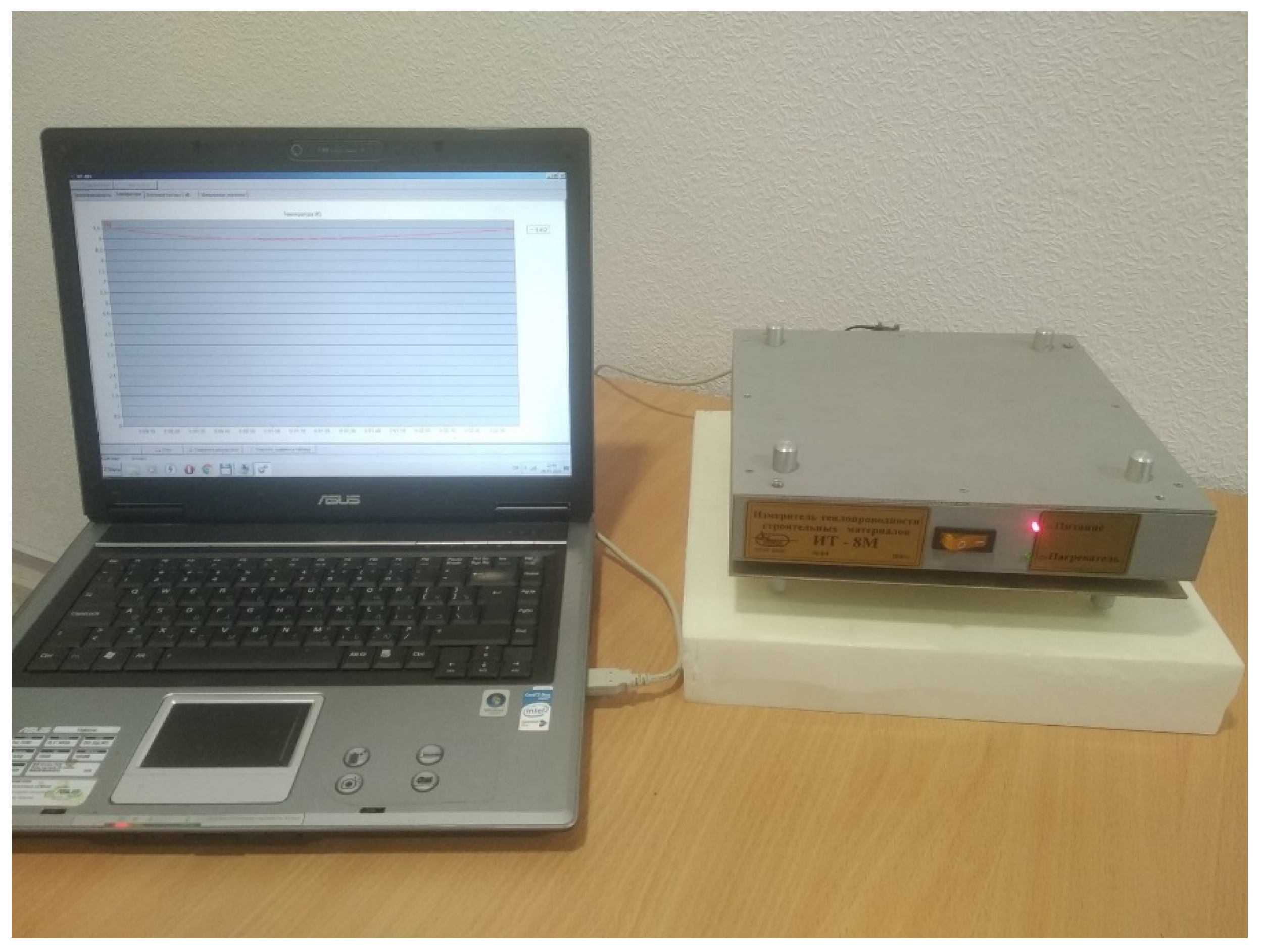


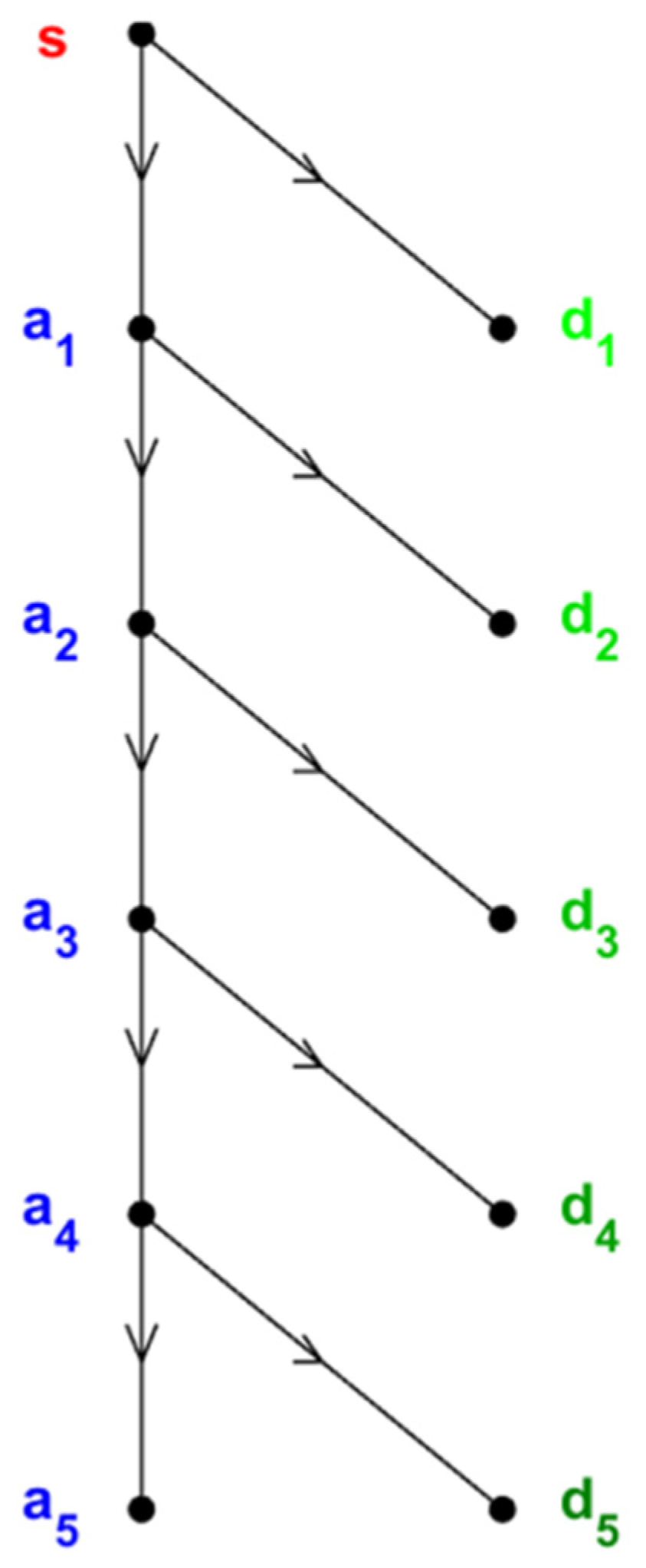
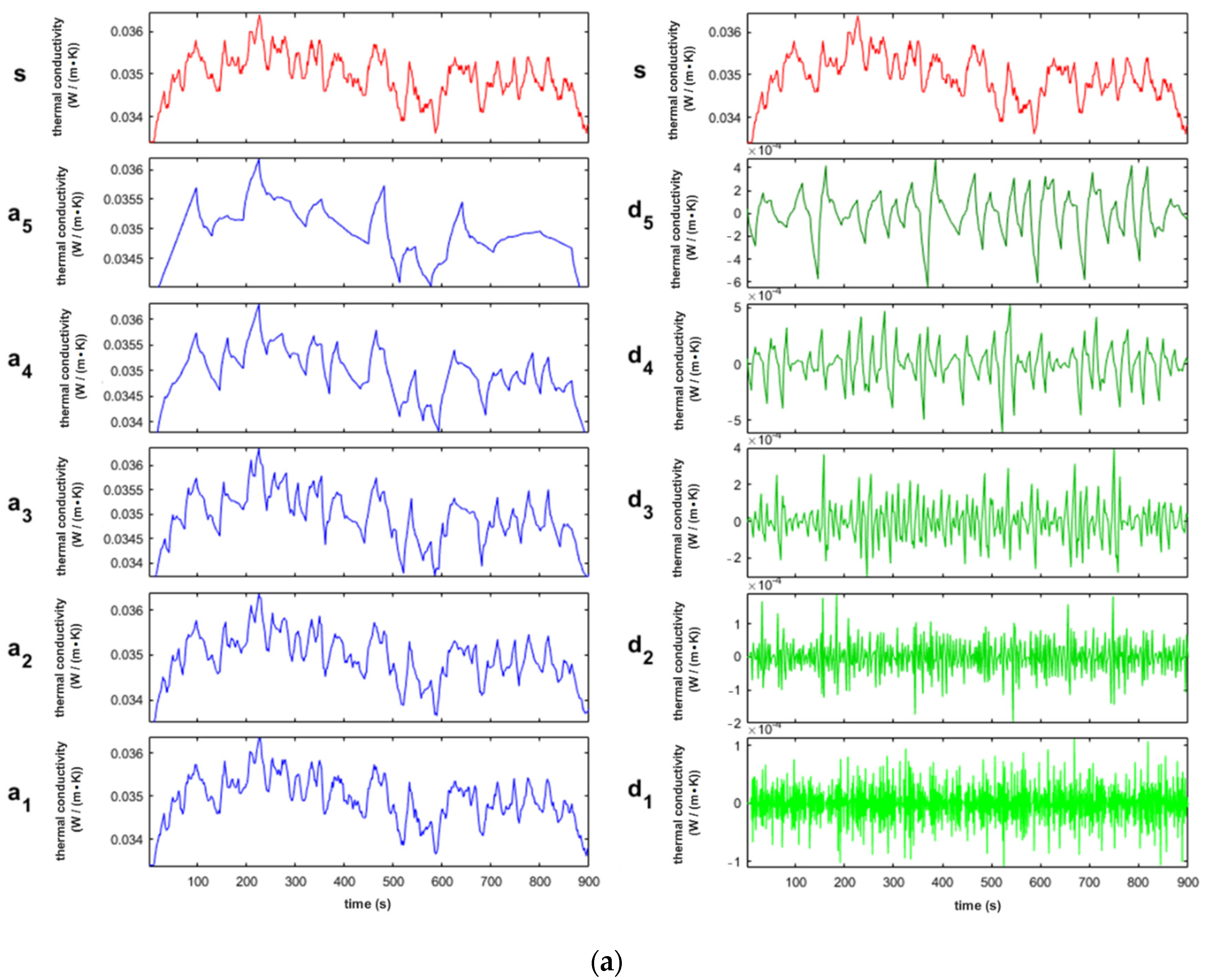
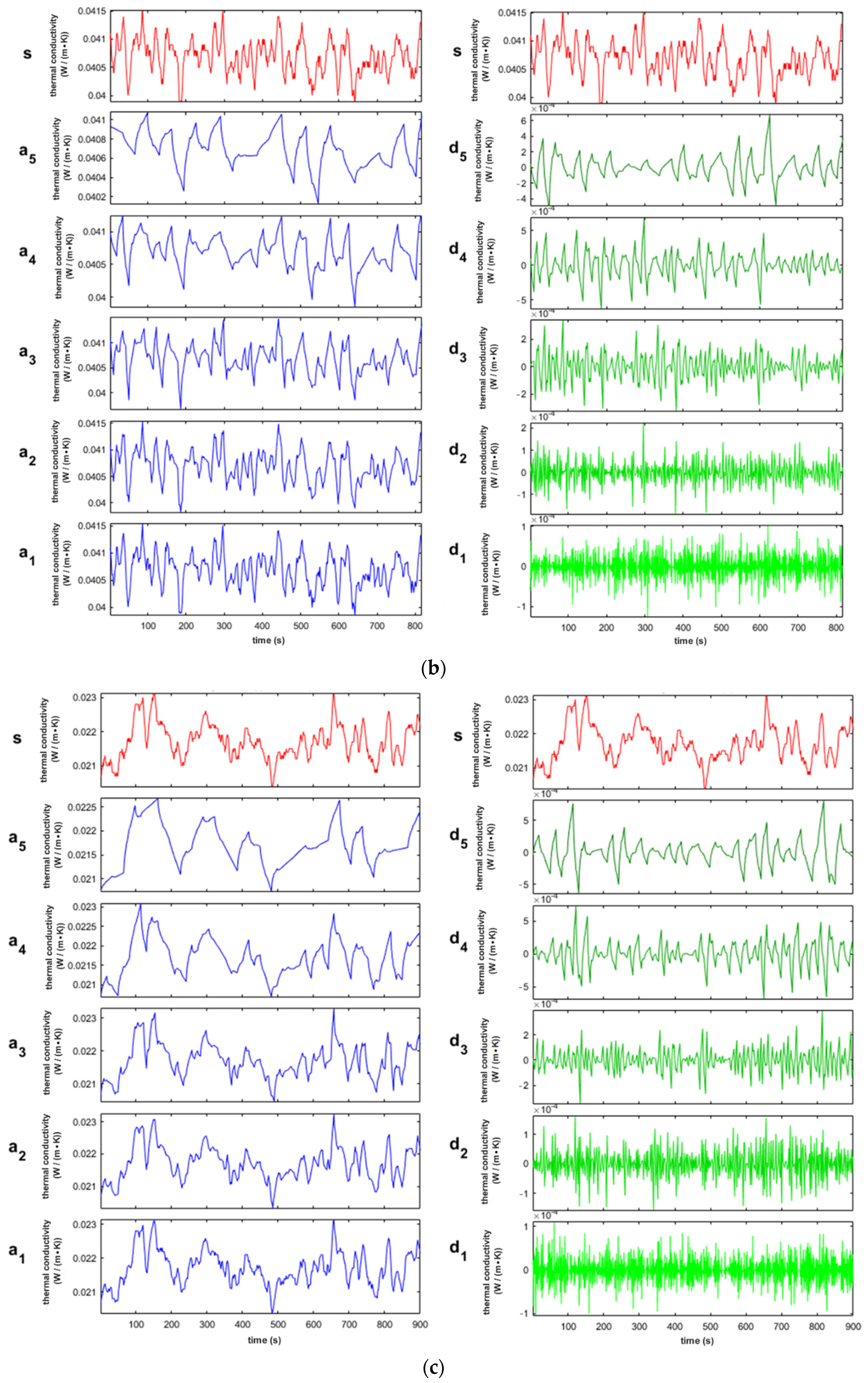
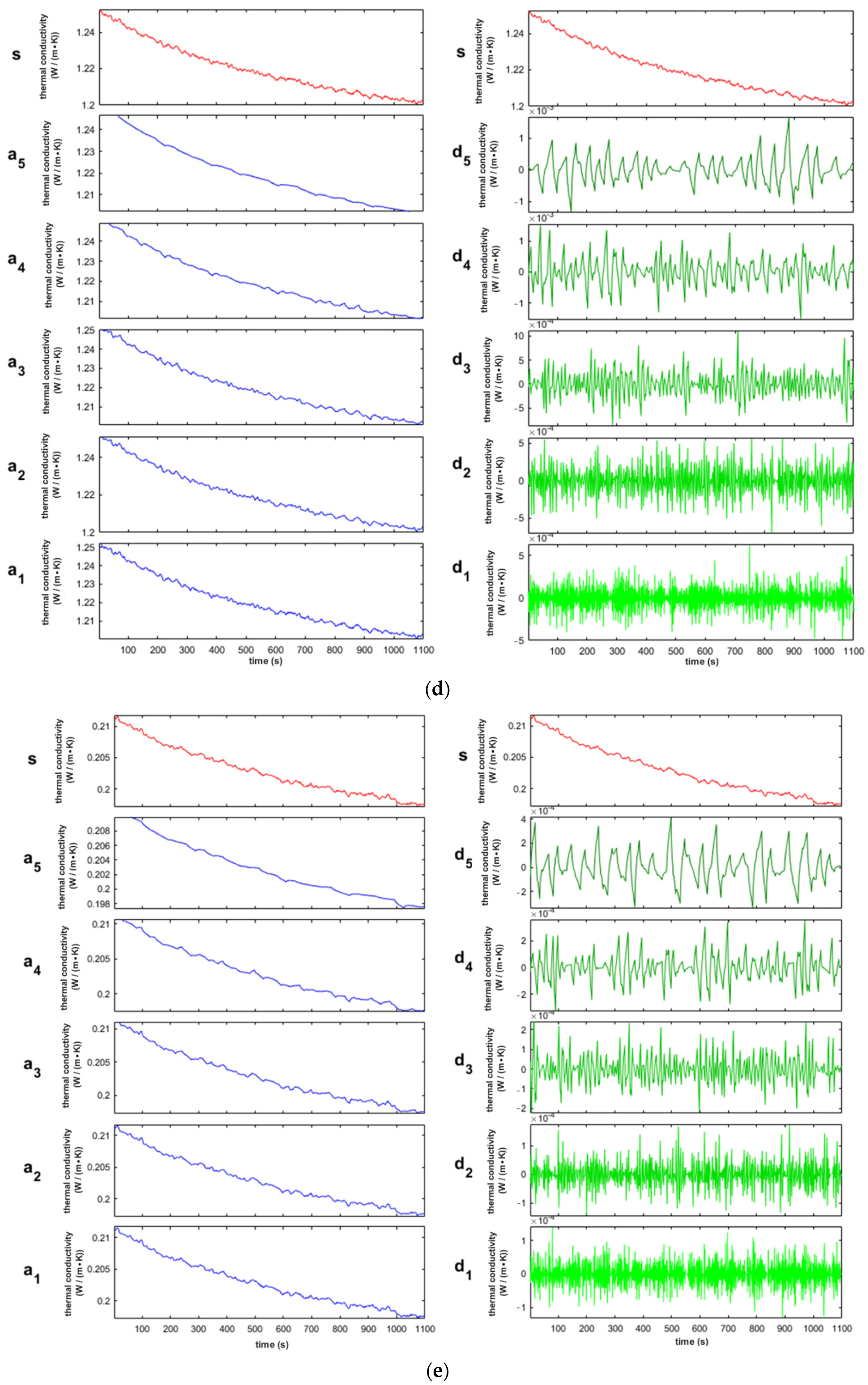

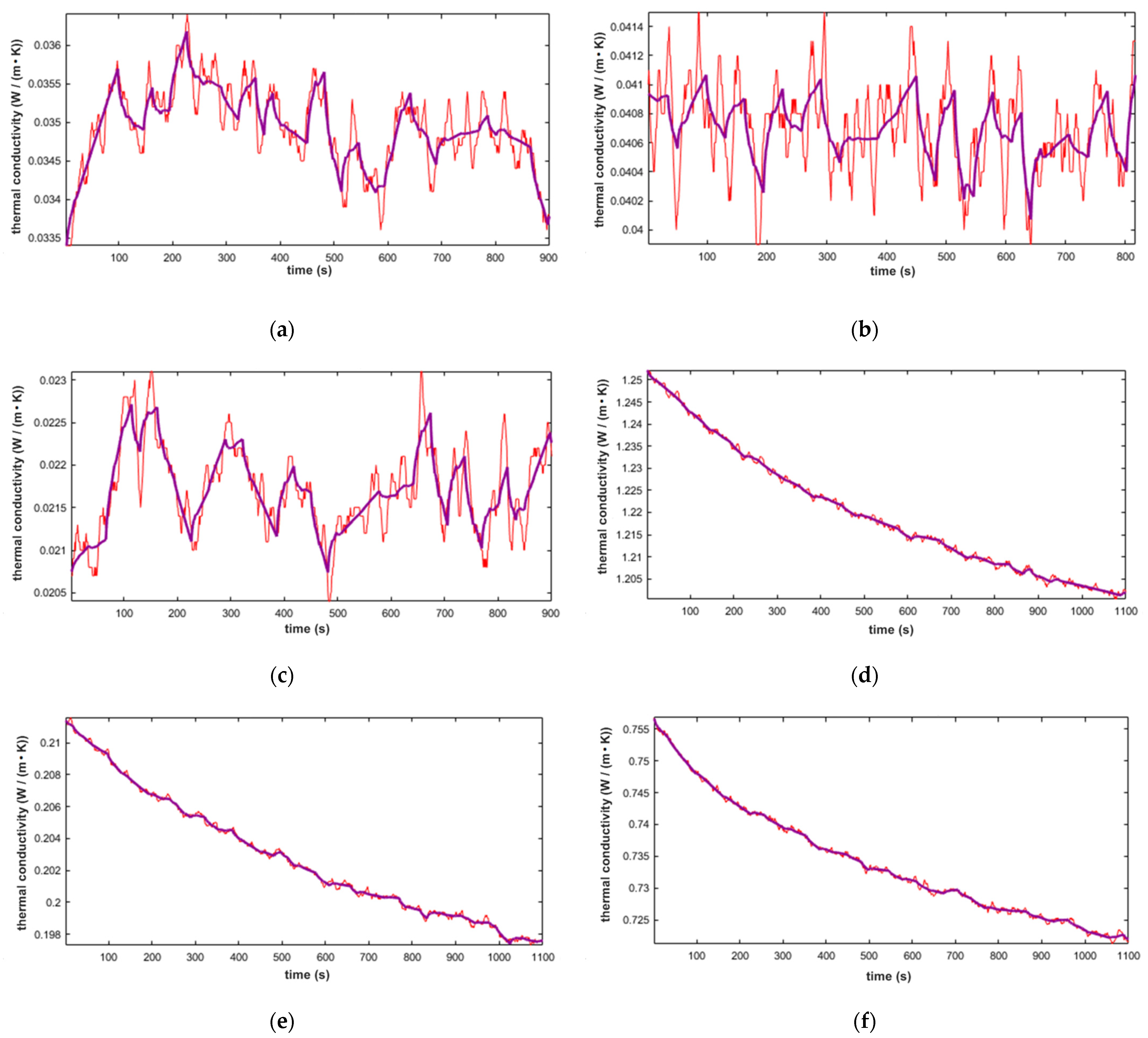
| Parameter | Values or Value Range |
|---|---|
| The range of measured values of thermal conductivity | 0.03 … 1.5 (W/(m∙K)) |
| The operating temperature of the sample | 25 ± 5 (°C) |
| Relative error | ±8 (%) |
| Duration of the measurements | 30 (min) |
| Sample Number | Sample | Thermal Conductivity Measured by the Heat Flow Meter Apparatus (W/(m·K)) | Thermal Conductivity Measured by the Express Control Device (W/(m·K)) | Standard Deviation | Relative Error (%) |
|---|---|---|---|---|---|
| 1 | Organic glass SOL | 0.1960 | 0.2022 | 0.0062 | 3.16 |
| 2 | Optical glass TF-1 | 0.7230 | 0.7322 | 0.0092 | 1.27 |
| 3 | Optical glass LK-5 | 1.1650 | 1.2172 | 0.0522 | 4.48 |
| 4 | Polyurethane | 0.0227 | 0.0217 | 0.0010 | 4.41 |
| 5 | Extruded polystyrene (XPS) | 0.0340 | 0.0349 | 0.0009 | 2.65 |
| 6 | Expanded polystyrene (EPS) | 0.0405 | 0.0407 | 0.0002 | 0.49 |
| Remark. The values of the thermal conductivity correspond to the temperature of the sample (293 K). | |||||
| Sample Number | Sample | Thermal Conductivity (W/(m∙K)) | Determined Thermal Conductivity Coefficient Using a db Wavelet of the Order of 2 at Decomposition Level 5 (W/(m∙K)) | Time (s) | Standard Deviation | Relative Error (%) |
|---|---|---|---|---|---|---|
| 1 | Organic glass SOL | 0.1960 | 0.2064 | 300 | 0.0072 | 5.3060 |
| 0.2031 | 600 | 0.0056 | 3.6200 | |||
| 0.1976 | 900 | 0.0038 | 0.8200 | |||
| 2 | Optical glass TF-1 | 0.7230 | 0.7417 | 300 | 0.0140 | 2.5900 |
| 0.7358 | 600 | 0.0134 | 1.7700 | |||
| 0.7226 | 900 | 0.0089 | 0.0600 | |||
| 3 | Optical glass LK-5 | 1.1650 | 1.2330 | 300 | 0.0317 | 5.8360 |
| 1.2190 | 600 | 0.0196 | 4.6300 | |||
| 1.2040 | 900 | 0.0140 | 3.3500 | |||
| 4 | Polyurethane | 0.0227 | 0.0218 | 300 | 0.0006 | 4.0132 |
| 0.0217 | 600 | 0.0005 | 4.5286 | |||
| 0.0217 | 900 | 0.0004 | 4.2907 | |||
| 5 | Extruded polystyrene (XPS) | 0.0340 | 0.0351 | 300 | 0.0006 | 3.3400 |
| 0.0350 | 600 | 0.0005 | 2.9500 | |||
| 0.0348 | 900 | 0.0005 | 2.3500 | |||
| 6 | Expanded polystyrene (EPS) | 0.0405 | 0.0409 | 300 | 0.0003 | 0.7010 |
| 0.0406 | 600 | 0.0002 | 0.2500 | |||
| 0.0406 | 900 | 0.0002 | 0.2500 |
Publisher’s Note: MDPI stays neutral with regard to jurisdictional claims in published maps and institutional affiliations. |
© 2021 by the authors. Licensee MDPI, Basel, Switzerland. This article is an open access article distributed under the terms and conditions of the Creative Commons Attribution (CC BY) license (https://creativecommons.org/licenses/by/4.0/).
Share and Cite
Hotra, O.; Kovtun, S.; Dekusha, O.; Grądz, Ż. Prospects for the Application of Wavelet Analysis to the Results of Thermal Conductivity Express Control of Thermal Insulation Materials. Energies 2021, 14, 5223. https://doi.org/10.3390/en14175223
Hotra O, Kovtun S, Dekusha O, Grądz Ż. Prospects for the Application of Wavelet Analysis to the Results of Thermal Conductivity Express Control of Thermal Insulation Materials. Energies. 2021; 14(17):5223. https://doi.org/10.3390/en14175223
Chicago/Turabian StyleHotra, Oleksandra, Svitlana Kovtun, Oleg Dekusha, and Żaklin Grądz. 2021. "Prospects for the Application of Wavelet Analysis to the Results of Thermal Conductivity Express Control of Thermal Insulation Materials" Energies 14, no. 17: 5223. https://doi.org/10.3390/en14175223
APA StyleHotra, O., Kovtun, S., Dekusha, O., & Grądz, Ż. (2021). Prospects for the Application of Wavelet Analysis to the Results of Thermal Conductivity Express Control of Thermal Insulation Materials. Energies, 14(17), 5223. https://doi.org/10.3390/en14175223







